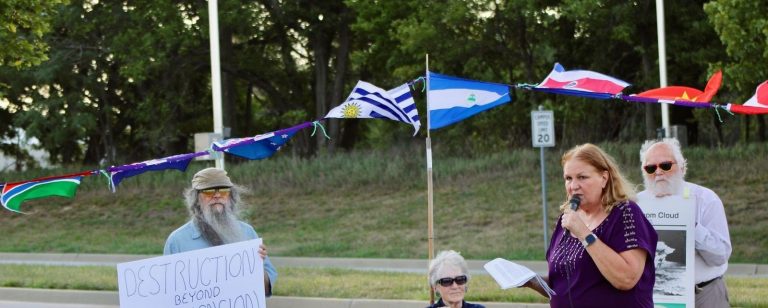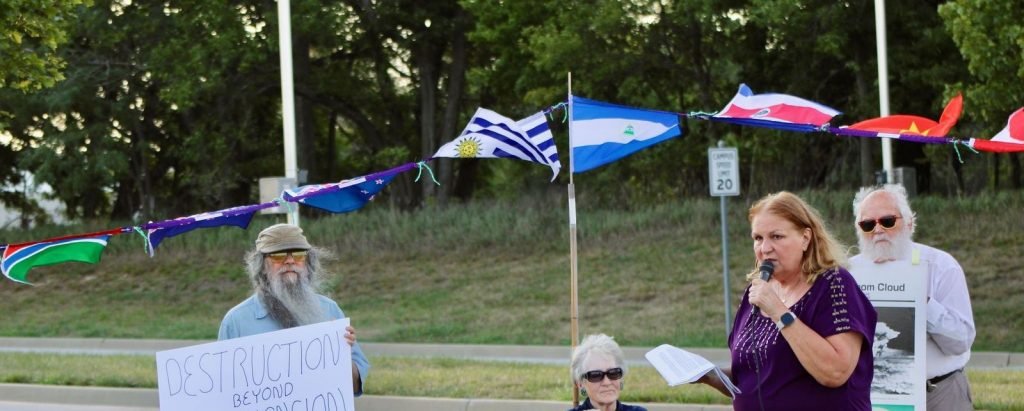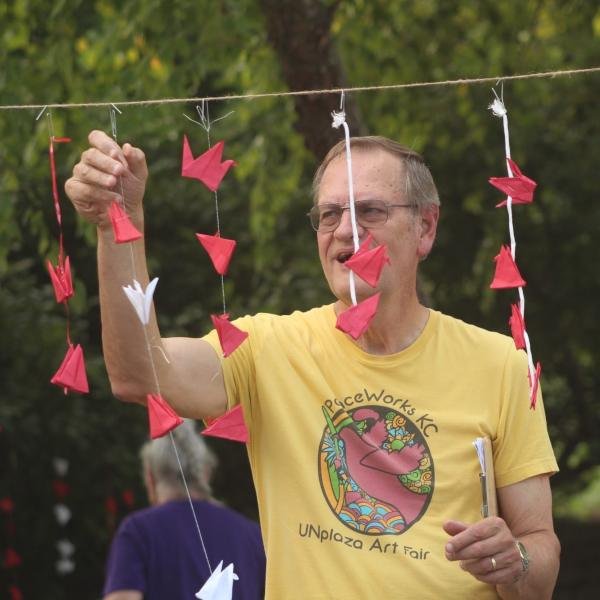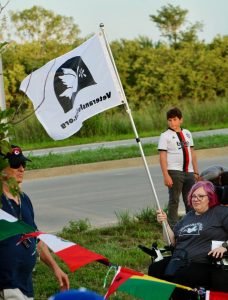
By Jane Stoever
Echoes. Hope. Two hands.
These came into play at “Remembering Hiroshima & Nagasaki: Never Again!” PeaceWorks Kansas City and Veterans for Peace cosponsored this annual event on Aug. 7 at the entry to our local nuclear weapons plant, the KC National Security Campus.
We thought only about 30 participants might come because of the heat (92o) and the distance to the south KC site, but 40 came, and an evening breeze and shade lifted our spirits. We met at the road to the sprawling $1.2 billion-a-year facility that makes or procures 85 percent of the non-nuclear components of US nukes.
Echoes
Hiroko Komiya, raised in Chiba, a suburb of Tokyo, Japan, echoed the words of Mrs. Keiko Baker, raised near Nagasaki and now 90, at this event last year. Mrs. Baker said of nuclear weapons: “The bomb was made by humans, dropped by humans, and suffered by humans … an utter devastation of human lives.”
Ms. Komiya insisted that the bomb can be taken apart by
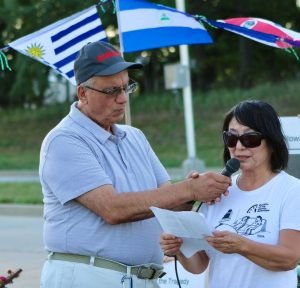
humans, adding, “The Russian invasion of Ukraine has raised the fear of nuclear weapons to a level not seen since the end of the war,” World War II—an echo of fear. Mrs. Baker is the honorary principal and founder of the Kansas City Japanese School, and Ms. Komiya is the principal.
Henry Stoever, a cochair of PeaceWorks, opened our program by saying, “Today we face our own global Hiroshima and Nagasaki” with the renewed nuclear arms race. He said some people say today’s bombs are 200-300 times more powerful than those we used in 1945, and some say they are 3,000 times more powerful. “We are at the brink of destruction, and we must save ourselves,” Henry said.
Hope
Ms. Atsuki Mori, who came from Osaka, Japan, and is a nurse who lives in Warrensburg, MO, hoped to reach a person via an Internet search. That person, whom Ms. Mori had met, is a hibakusha, a survivor of the Hiroshima blast. Ms. Mori lived with her grandmother, a physician, until age 14, and they had gone together a few times to visit friends in Hiroshima, including the family of her grandmother’s former fiancé, Dr. Ueki, who died from tuberculosis before the US bombed Hiroshima. The fiancé’s brother had a son who, as a baby, lost the sight in his left eye from the glass in a kitchen window that shattered with the bomb blast. The nephew’s mother was able to shield her baby, all but his left eye. Ms. Mori and her grandmother visited the Hiroshima Peace Memorial when Ms. Mori was 6 or 7 years old, an visited the former fiancé’s brother and nephew.
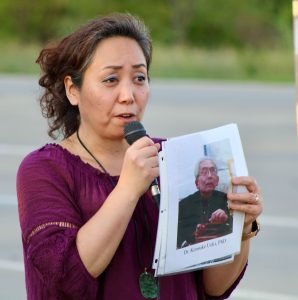
Ms. Mori could not forget the scar on the nephew’s eye. “Even though the only clues I had were the last name and scarred eye,” she told us, “I was hopeful. So I entered keywords in the search engine, and soon I found an older man with a scarred eye named Kensuke Ueki. Somehow, I found his home phone number. So I thought to give it a shot. A woman answered the phone and said it was the Ueki residence. I asked her if she knew Atsuki Mori (me), and she did. I was able to talk to Dr. Ueki’s nephew, also a Dr. Ueki.”
The nephew Dr. Ueki has been a leader in ICAN, the International Campaign to Abolish Nuclear Weapons, which PeaceWorks joined last year, and he said of our Hiroshima/Nagasaki remembrances, “I thank my American friends for seeking the truth about Hiroshima and Nagasaki. That gives me hope for abolishing nuclear weapons.”
Referring to the flags at our event, Ann Suellentrop of the PeaceWorks Board asked, “Why do we fly these colorful flags today? Because they are a sign of great hope! They are the flags of the 66 countries that have ratified the Treaty on the Prohibition of Nuclear Weapons.”
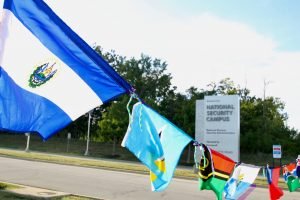
It’s the first treaty, said Ann, to call for complete destruction of all nuclear weapons and for compensation for the victims of nuclear production, use and testing, as well as for environmental remediation. “Good news is steadily being reported,” she added, “such as a bank in Italy deciding to totally divest from nuclear weapons. The Treaty has stigmatized nuclear weapons, making them controversial investments.” She asked us to call for universities—including UMKC and KU—to stop sending students to summer jobs or internships in nuclear weapon facilities such as the KC plant.
Two hands
Sunny Hamrick of the PeaceWorks Board chose the song “With My Own Two Hands,” by Ben Harper, for our program’s closing on Aug. 7. Sunny echoed the words of Mrs. Baker and Ms. Komiya, saying, “The bombs are made by humans, dropped by humans, and can be taken apart by humans.” Referring to the huge complex of buildings on the “campus,” the National Security Campus, he said, “Look at your two hands right now.” He asked us to think of what we can do to make peace, noting, “The people in these buildings are creating nothing but destruction.”
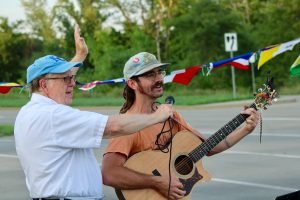
Then he led us in singing:
I can change the world with my own two hands.
I can make peace on Earth with my own two hands.
I can clean up the Earth with my own two hands.
I can take bombs apart with my own two hands.
—Jane Stoever is cochair of the PeaceWorks Communications Team. For transcripts of talks by Hiroko Komiya, Atsuki Mori, and Ann Suellentrop, plus more stories/pictures, see www.PeaceWorksKC.org. © 2022, Jane Stoever, Jim Hannah, Hiroko Komiya, Atsuki Mori, Ann Suellentrop, Henry Stoever, Sunny Hamrick, Creative Commons Attribution Share-Alike 4.0 International License.
